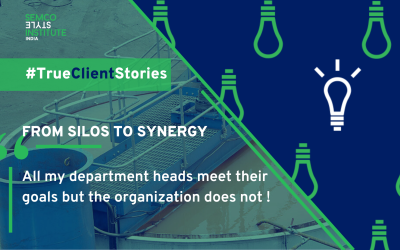
A renowned social entrepreneur had built a multimillion-dollar business by engaging artisans in rural India and thereby giving them a livelihood. While they were growing and going global, they were facing problems with delayed delivery of the end product, hurting them significantly in terms of money and goodwill. Semcostyle Institute India was engaged to demonstrate how a self-managed and empowered team can solve problems that seem complex from the outside.
Most of the work was done in the villages and by artisans who spoke native languages and had limited or no formal education. On the other hand, the “office”, where most decisions were made, was full of people with access to technology, resources, and data. Unsurprisingly, every time the challenge of OTD came up, both sides would say – what do they know? The lack of alignment between headquarters and field teams was stark.
As one of several interventions to enhance alignment, we got representatives from all functions to come together and visualize the value chain and what role each of them plays in that. We empowered field teams in the villages to determine what data they needed, how it should be delivered, by whom, and when. We started with an improvised form of a simple ritual – “daily standup” with a small cross-functional team. Over four weeks, the team designed easily readable reports that everyone could understand. Armed with the information that they could relate to, the team began making critical decisions like when to set up and offload the looms, dispatch completed products, and arrange logistics for shortages in raw materials – focusing on improving OTD. Within six weeks, with no additional investment or manager involvement the OTD improved from 40% to 70% for the pilot teams.
The team weaved the magic with five simple practices – #InformationBelongsToEveryone, #LetsLearnTheNumbers, #BoundariesOfAction, #RhythmOfGovernance and #PurposeAlignment Incidentally, these are the foundation of building self-managed teams.
#ShapingTheFutureOfWork #DrivingBusinessResults #HumanCentric
To learn more about how we help organisations become self-managed, resilient and thus future-ready, click here.
Related Posts
Taking Agile to Warehouse Management
The myth about Agile is that it’s only for IT teams. Here is a case that shows how, if implemented well, it can help achieve better outcomes even in operations.
From Silos to Synergy – Mining a new formula for success
Breaking down silos is more of a mindset change than structural. Read on to see how alignment, clarity and transparency positively impact business outcomes.
Leaders step-back Teams step-up
A mid-sized engineering design and construction company based in the outskirts of Chennai approached us with a problem of stagnating growth despite bringing in lateral leadership talent. The employees, largely drawn from small towns of Tamil Nadu,...



